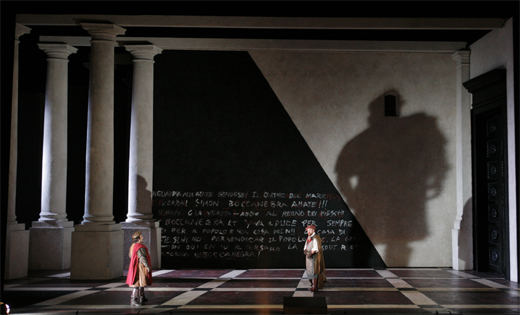 United States G. Verdi, Simon Boccanegra: Soloists, LA Opera Orchestra & Chorus, James Conlon (conductor), Dorothy Chandler Pavilion, Los Angeles, 15.2.2012 (RRR)
United States G. Verdi, Simon Boccanegra: Soloists, LA Opera Orchestra & Chorus, James Conlon (conductor), Dorothy Chandler Pavilion, Los Angeles, 15.2.2012 (RRR)
Production: Royal Opera House, Covent Garden
Direction: Elijah Moshinsky
Sets: Michael Yeargan
Costumes: Peter J. Hall
Lighting: Duane Schuler
Cast:
Simon Boccanegra: Placido Domingo
Amelia: Ana Maria Martinez
Jacopo Fiesco: Vitalij Kowaljow
Gabriele Adorno: Stefano Secco
Paolo Albiani: Paolo Gavanelli
Pietro: Robert Pomakov

On February 15, I went to see Giuseppe Verdi’s Simon Boccanegra at the Los Angeles Opera. I will admit my apprehension up front: I last heard Plácido Domingo sing in Cyrano de Bergerac at the San Francisco Opera in November, 2010. (Review here.) Cyrano is very much an Errol Flynn kind of role, and Domingo was stretching it, physically, if not vocally, in playing the part.
Could he then, at age 71, pull off the demanding baritone role of Simon, especially in the first act, where he is supposed to appear as a relatively young man? I am now almost ashamed of having asked myself the question. Domingo’s voice is still fresh enough to assume this role, and he still has the energy to do it convincingly. He sang all out and had no trouble portraying the young Simon—and was even more convincing than as the aging Doge.
  G.Verdi, Simon Boccanegra, C.Abbado / OdT alla Scala / Freni, Cappuccilli, Carreras, Ghiaurov, van Dam, et al. DG     –> –> |
Boccanegra was not a success when it premiered in 1857 and only found its audience after it was revised for another production in 1881. The plot is still a creaky melodrama—there is almost no character development, and things just happen unaccountably—and one can only imagine it’s infelicities before librettist (and composer in his own right) Arrigo Boito improved upon the first version. But Verdi’s music, also revised, is unfailingly engaging and perfectly fashioned for the dramatic situation. It is gripping throughout, except for the um-pah ostinato he uses in Amelia’s first aria.
I shan’t give a précis of the plot, but simply say that it is driven by the fact that no one is in their proper place. The father is bereft of his daughter. The mother was not married to the father. The aristocrats are not ruling; the plebeians have taken over. The daughter of the aristocratic Grimaldi family is not who she seems, but the daughter of a pirate. The lovers are separated by family animosity. These discordances breed vengeful desires that threaten to overthrow the political order.
Because no one is in their proper place, everything is out of sorts. What can restore the equilibrium? Extraordinarily enough, the answer is love, as manifested in Simon’s love for his daughter, his daughter’s love for him, and the mutual love between the daughter and her fiancé Gabriele. However, the price for resolution must be paid in ample grief and death. Verdi once thought the opera “too sad, too depressing.” You will not leave humming.
Verdi put conflicts and discordant relationships to good use, though, writing radiant duos, trios, and ensembles. While the opera lacks traditional arias, one hardly misses them amid the vocal glory on display, and the orchestral writing is riveting.
The music is aided and abetted by an outstanding production. Aside from the role of Simon, the part of his daughter Amelia is key. This was filled by soprano Anna Maria Martinez, who was glowing in the role, both vocally and dramatically. The glorious recognition scene between Amelia and Simon, in which the father and daughter reunite after 25 years, was everything one could wish it to be, with complete cohesion of acting, singing, and pit.
The villain Paolo was effectively portrayed by Paolo Gavanelli; the angry aristocrat, Fiesco, was given tremendous gravitas by bass Vitalij Kowaljow. Gabriele Adorno, Amelia’s lover, was sung by Stefano Secco, who excelled vocally, but failed to make sparks fly in the love scenes with Amelia.
James Conlon, conducting the LA Opera Orchestra, was every bit a principal in this production. He and the orchestra gave a sumptuous, engagingly dramatic portrayal. The sets from the Royal Opera House, Covent Garden, were a neoclassical delight, drawn in exaggerated Renaissance perspective. The costumes were period and apt. The staging was surefooted. The only awkwardness occurred when the Doge was placed downstage from his court, which he could then not directly address: A concession of voice over drama.
Simon Boccanegra plays through March 4th. Get thee thither.
Robert R. Reilly